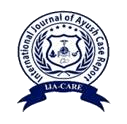Ayurvedic Management of Indralupta with special reference to Alopecia Areata: A Case Report
Abstract
Alopecia areata (AA) is a common form of non-scarring hair loss of scalp and/or body. Genetic predisposition, autoimmunity, and environmental factors play a major role in the etiopathogenesis of AA. Patchy AA is the most common form, with an incidence of around 0.7% in northern India. Conventional treatments like corticosteroids often result in unwanted side effects such as skin thinning, skin atrophy etc, prompting exploration of alternative therapies. This case study presents the successful management of AA using Ayurvedic approach that includes Kuttana Karma(~microneedling with a 1 mm Derma-roller) and Shirolepa (~herbal paste application), along with internal Ayurvedic medications. A 22-year-old woman with patchy hair loss and a SALT score of 22% sought treatment after seeing no results with earlier therapies. She underwent a one-month treatment plan involving weekly Derma-roller sessions, daily application of Rakta Gunja beeja choorna lepa (10gm) and oral intake of Rasayana choorna (6gm)Over the course of treatment, she experienced steady improvement in hair growth. By the final visit, the SALT score decreased to 0%. The combination of microneedling and Ayurvedic therapies helped to improve scalp blood circulation, nutrient absorption addressing the disease root cause. This case report suggests the effectiveness of Ayurvedic management in treating Indralupta (~AA).

This work is licensed under a Creative Commons Attribution-NonCommercial-NoDerivatives 4.0 International License.

